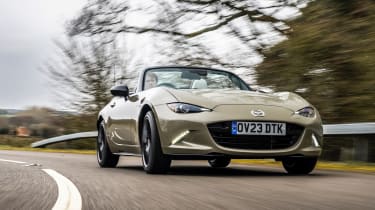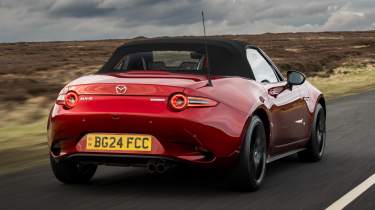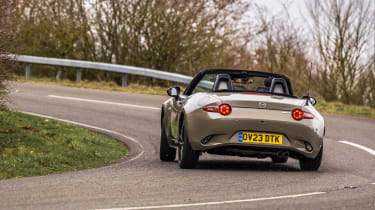Mazda MX-5 review – ride and handling
Sure to impress casual drivers, but may leave some wanting more. Plenty of body roll and some body shake, too
The Mk4 MX-5 has been passionately designed, developed and honed around one goal: to offer interaction and a sense of speed and fun for everyone. As part of that, the car has been set to initially roll heavily when a steering input is made, and to lean on the tyre sidewalls. The settings also cause it to pitch and squat a little more than you’d expect when the brakes and throttle are used too. This may well give a strong impression of speed, but it can be disconcerting if you take a shortcut to the car’s limits, as the initial impression is of a wallowing, somewhat vague car.
The MX-5’s real limits as a challenging performance car start to show when the going gets rough though. It’s all down to the chassis, which for all its lightness suffers in terms of stiffness, or rather the lack of it. Barrel down a broken B-road and the structure shudders and wobbles, as the chassis struggles to contain the impacts coming in from the suspension.
The springs really should iron out smaller bumps and road intrusions, but instead the brittle dampers transmit this noise into the cabin. Wheel control is also compromised, as the wheels have a tendency to crash into road irregularities.
More reviews
Group tests
In-depth reviews
Review
Reviews
- Performance Link Mazda MX-5 R300 review – an MX-5 with Honda VTEC power
- Mazda MX-5 RF 2025 review – evo Car of the Year 2024’s people’s champion
- BBR Supercharged Mazda MX-5 (NC) 2022 review – frenzied, affordable fun
- Mazda MX-5 R Sport 2020 review – floats like a butterfly, but stings like one too
- BBR Super 225 Mazda MX-5 review
This MX-5 is the first of its ilk to use electric power assistance for the steering, and while the engineers have succeeded in making it accurate, predictably it doesn’t possess the more natural weighting and progressive responses of the best hydraulic racks – or indeed its sweet-steering predecessors.
An acceptance of the car’s limitations, plus a calm, precise driving style, suit the MX-5 much better. Only 2-litre cars have the limited-slip differential – now a revised ‘asymmetric’ item – and a strut brace, as it’s the only one of the two that you’d expect to have enough grunt to worry the rear tyres. Actually, the excessive roll means that the 1.5’s inside rear wheel is easily unloaded and has a tendency to spin in tight corners, even in the dry.
The 2-litre won’t slide around extravagantly in the dry, and the large body movements soak up tamer attempts to unsettle the car, but if you’re committed enough, or on a circuit, it’ll happily transition into oversteer at speed moreso with momentum, rather than at the behest of a floored throttle. Holding it in this state requires lots of throttle to keep the rear tyres spinning and the revs up high where the engine gives its best; truth be told, the soft MX-5 doesn't feel entirely comfortable doing this at speed on a less-than-smooth surface.
This isn’t just an issue when being a hooligan; braking late, high cornering speeds and large amounts of throttle can also create a disjointed and scruffy driving experience. The lack of an LSD in the 1.5 means it is even more unpredictable if you do provoke it into a slide. Having said that, it’s possible to corner at neutral or mild oversteering angles at sane speeds in either version.
Dial back your efforts and calm your inputs and both can be very satisfying to drive, but it’s easy to push too hard and lose the rhythm that makes them so pleasing. On unfamiliar back roads, where you aren’t confident of the severity or direction of the next corner, where you need a car that will respond just as you expect, the MX-5 is in its element. Without committing to a corner too eagerly you can get on the throttle early to manipulate the rear and constantly adjust your line right through to the exit.
The new for 2024 asymmetrical limited-slip diff gives wider scope to explore this balance, with excellent controllability right up to and over the limit. The new Track Mode in the DSC is designed to allow you to enjoy the added bandwidth the diff affords while retaining a safety net at the very extremes. This works to an extent on the road but, finding a rhythm with the MX-5 as one quickly does, it’s a stepping stone to turning it all the way off. On track, you’ll be nanny-free within a lap or two in dry conditions.
Bilstein dampers are standard on the top-spec 2-litre Homura version, and this is undoubtedly as serious as an MX-5 gets. They do make for a firm ride at low speeds, which particularly on urban roads sends a tremor through the MX-5’s structure. The fancy dampers provide more control and allow you to drive the MX-5 harder at speed, while still allowing you to enjoy many roads that would test the bump stops of many heavier, stiffer-sprung performance cars. Thankfully, the brakes are easily up to the task at road speeds, with a measured (if not outstanding) initial bite.
Mazda has gone to great lengths to make the RF feel the same as the roadster to drive, and it does to an extent. The extra weight of the folding roof has been compensated for by using revised springs, dampers, anti-roll bars and rear suspension geometry, which offer a similar overall character to the soft-top under normal driving.
The bulkier roof has also increased the car’s structural rigidity, but Mazda felt that it changed the balance of the car too significantly so one of the lower chassis braces has been altered to allow more twist. Indeed, the RF exhibits a familiar tendency to quiver and patter over rough surfaces, but this is exacerbated by a slightly more abrupt reaction to bumps.
Interestingly, there's a noticeable difference between the two when you reach the limit, with the RF adopting a more stable stance. The latest soft-top MX-5 we drove was surprisingly reactive to throttle inputs, the nose hooking up sharply with a lift and the rear eagerly carving a wider arc under full power. This keenness to rotate could be unnerving at times – Track Mode isn’t entirely redundant in this case – and didn't always feel entirely natural, with the MX-5's inherent softness making it difficult to read those first few degrees of slip, though that new diff gives more breathing room beyond.
This could be the MX-5's Kinematic Posture Control at play, which applies the brakes to the inside rear wheel to effectively reduce roll. Whatever the case, the RF is less excitable despite being equipped with the same system, and you need to be more deliberate to make it dance. This, coupled with slightly cleaner steering with less friction in the rack, gives the RF a marginally more organic – if less exciting – feel at the extremes. Roof down, the RF does suffer with buffeting more at speed than the Roadster.




